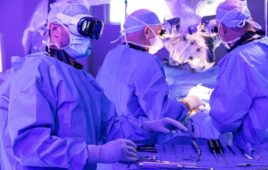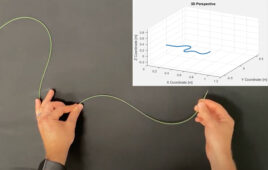Harpreet Kaur, Ph.D., 3M Medical Specialties

One of 3M Health Care’s advancements: 3M Transparent Adhesive to provide durable positioning yet transparency to locate the IV.
Over the past few decades, adhesives in one form or another have been replacing many other fastening systems in the assembly of medical devices. Adhesives come in many different forms to address various needs such as, structural, non-structural and pressure sensitive adhesive. When chosen judiciously, adhesives can offer significant benefits over other mechanical fastening systems.
A few general benefits of using various adhesives over mechanical bonding techniques include a:
- Strong, uniform bond
- No holes to drill or leak through
- Maintain material integrity and prevent potential corrosion, such as rusting
- Improved durability
- Distribute stress uniformly over the bonded surface versus. stress risers at screws and rivets
- Bond and seal simultaneously
- Join dissimilar or hard to bond materials, sometimes without much surface preparation
- Improved appearance with thinner, uniform bond
- Design flexibility
- Can save time
- Can be cost effective
- Cleaner manufacturing environment, depending on adhesive selection
- Ability to disassemble when needed, depending on adhesive selection
- Can be easier to automate the application process
Adhesive categories:
Adhesives are generally categorized as structural, non-structural and pressure sensitive. The right adhesive should bond well to the substrates and provide a strong enough bond for the application requirements.
Structural adhesives can be one or two-part epoxies, acrylics or urethanes, which are used for load bearing applications. These are chemically curing compounds and typically offer the highest strength. They can be used to bond metals, plastics, rubbers and other difficult to bond materials, sometimes without much surface preparation. They allow for bonding a wide selection of materials.
Structural adhesives are also used in a wide range of applications, from bonding surgical instruments together to rubber bumpers to the bottom of crutches and walking canes and plastic soles to the bottom of cast boots. Traditionally these applications would have required the use of nails, screws or rivets.
Cyanoacrylates, which are fast curing and widely used in the medical device industry, fall in the structural adhesives category. Cyanoacrylates are moisture-cured liquids. Some cyanoacrylates are formulated as dual cure systems that include a moisture and a light cure (UV or visible) mechanism. These can be used in the manufacture of IV tube sets, needle bonding or attaching plastic tubing to a blood bag. Traditionally, strong solvents are used for making these bonds.
Non-structural adhesives are a broad category that includes hot melts, contact, aerosol and rubber and gasket adhesives, among others. These adhesives do not cure chemically but instead attach physically, such as hot-melt adhesives that solidify on cooling, solvent or water based contact adhesives that bond as they dry.
These adhesives are generally used to join surfaces that do not see an excessive load under normal use, and create effective bonds as they maintain flexibility after bonding. Adhesives in a range of bond strengths are available to meet specific needs. These adhesives can bond rubbers, plastics, fabric, foam, leather, metal, glass and more.
Spray adhesive can be used in the construction of equipment carrying cases to attach foam to foam or to the carrying case. Hot melt or spray adhesives can be used to bond fabric to wood, plastic or metal for wheelchair seat cushions, thus avoiding stitching or riveting.
Pressure sensitive adhesives (PSA) are now commonly used in the assembly of medical devices. When first applied, these need pressure to form a good bond. PSAs function because of the viscoelastic properties of the adhesive. This means that the adhesive can flow into the surface because of the viscous nature and resist stress due to the elastic nature. For non-uniform surfaces, the adhesive can cold flow into the nooks and crannies of the substrate due to the viscous nature of the adhesive, thus increasing the contact area and also creating a mechanical bond.
PSAs are used in bonding any number of flexible and non-flexible materials and the bond strength can be moderated by selecting the appropriate adhesive family, such as acrylic, synthetic rubber, silicone and hydrogel. PSAs offer a lot of flexibility, in that the adhesive properties can be formulated from being repositionable to ultra-high bonds.
A common application of PSA is in the assembly of blood-glucose monitoring strips, to bond and seal together the various layers of the device quickly and easily. PSAs are also commonly used for attaching products to skin, such as a surgical drape to the patient skin, a first aid dressing for cuts and bruises, or an insulin pump to skin. PSAs offer a key advantage in that the two substrates need not be attached at the same time. The PSA can be applied to one surface at manufacturing and it can later be easily bonded to the second surface with the application of pressure.

Surgical Drape adhesive is an example of a one-time use adhesive; however, it has incredible strength.
Selecting the right adhesive for the application:
Before selecting an adhesive, it is critical to understand the design and application of the device, the materials being used in the construction and application of the device, the environment it will be exposed to from manufacturing to end use, the stresses it will see during the same period, the desired durability and shelf life, to name a few considerations. When an adhesive is applied to a non-standard surface such as skin, it presents a whole different series of challenges and appropriate questions that must be addressed for the application to succeed.
For applications to skin and certain In Vitro Diagnostic (IVD) devices, such as glucose monitoring strips, it is also important to ensure appropriate compatibility of the adhesive being used, per applicable ISO guidelines.
Common stresses seen on any bond are tensile, shear, peel or cleavage, depending on the joint design and the forces applied to it. The right adhesive selection and testing has to be done to test the adhesive bond during the development phase.
Adhesive bonds typically fail in adhesion or cohesion. An adhesion failure occurs at the bond line between the adhesive and substrate. A cohesive failure is an internal failure of the adhesive itself. For a good bond, neither failure should occur when the product is stressed during application.
A few questions to address when selecting the adhesive and adhesion technique for your application include what is the:
- Strength of the desired joint?
- Surface area available for adhesive application?
- The environment the device will be exposed to, e.g. heat, humidity, chemicals, UV and more?
- Desired method of adhesive application or limitations for application techniques that can be used, e.g. spray, hot melt, PSA and more?
- Required shelf life?
- Materials being joined, specifically the surface energy of the substrates involved?
- Surface characteristics of the substrates?
- How and where the device will be used and the force or stress seen by the joint?
- Storage conditions?
- Others?
If the adhesive is to hold a device to skinâa non-standard surface with properties varying from person to person and over time for the same personâspecial considerations should be accounted for to allow for a successful attachment.
For skin application, it would be important to know answers to the following questions, among others:
- To which part of the body is the device going to be applied?
- Is the device meant for a special segment of the population, such as Geriatric, Neonatal?
- Is the application a onetime use (such as Surgical drape) or long term use (such as Ostomy appliance)?
- Will the device be sterilized, and if so, what is the proposed sterilization method?
- What conditions will the device be subjected to during use, such as sweating, swimming and more?
- Which chemicals, if any, will the device come in contact with during use?
- What stress forces will the device see during use and removal?
Adhesives offer a number of advantages over other fastening systems. For a successful outcome, it is important to know and understand the properties of the substrates involved, define the bond requirements well, identify all the environmental conditions the bond will be exposed to, select the most appropriate adhesives and then test and narrow the choices to the optimal product for the application. A number of adhesive are available and there is no such thing as âone adhesive fits all.â
3M Health Care
www.3m.com






